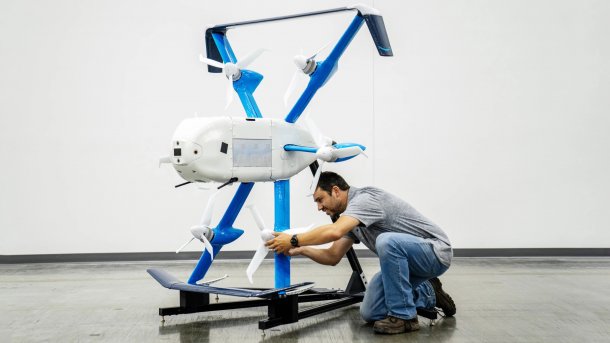Amazon.com allowed to fly drones beyond visual range in Texas
Amazon.com is hoping to deliver parcels in Texas much more often using drones. The new authorization to fly beyond visual range will help with this.

The new MK30 drone from Amazon Prime is said to fly faster, quieter and further than the previous version.
(Image: Amazon Prime Air)
Amazon.com is now allowed to fly drones beyond the visual line of sight of their pilots (BVLOS). This applies to a small part of the US state of Texas, around the town of College Station (population 120,000). According to the company, it has received approval from the US Federal Aviation Administration (FAA) for its Prime Air drone division. It is starting with the current MK27-2 drone model, and an environmental impact assessment is also underway for the use of the future MK30 delivery drone.
At twelve kilometers, the battery-powered MK30 hexacopter is said to have twice the range of its predecessor, the MK27-2, and can also be used in light rain. Accordingly, Amazon wants to quadruple the operating area around the Prime Air site near College Station to 450 square kilometers. This corresponds to a good 0.06 percent of the area of Texas. The maximum payload is still five pounds (around two and a quarter kilograms). However, the MK30 is not yet ready for series production.
At the same time, Prime Air wants to fly longer and more frequently. The operating times are to be extended from a maximum of eight hours on 260 days per year to 10 hours every day. This would be accompanied by an increase in the maximum number of permitted delivery flights from 52,000 to a good 171,000, with the drones flying to customers at an altitude of 180 to 279 feet and back again at 280 to 377 feet. In this way, they do not get in each other's way and ensure less noticeable noise on the ground on the return flight.
Autonomous avoidance system
More importantly, the drones do not get in the way of other aircraft. "We've spent years developing, testing and refining our built-in detection and avoidance system," reports Amazon, "to ensure that our drones can detect and avoid obstacles in the air." With demonstrations of how the system can avoid airplanes, helicopters and hot air balloons, Amazon has convinced the FAA to issue BVLOS approval. Without this exemption, pilots would never be allowed to lose sight of their drones, which severely restricts their operating radius.
Several other drone operators have received BVLOS permits earlier. Amazon had to wait longer because a drone got out of control during a test flight in 2021. Several safety systems failed, the aircraft crashed and caused a hallway fire.
Amazon is lagging behind
A year ago, Amazon had to admit that it had only carried out 100 delivery flights to customers. The competition was already a step ahead: Walmart service provider Droneup reported 110,000 deliveries by drone in the USA. Alphabet subsidiary Wing spoke of 330,000, and Zipline even claimed 600,000, although a large proportion of these were in Australia and Africa respectively. Zipline now has more than one million delivery flights to real customers.
Amazon would like to eclipse these figures: The plan is to deliver 500 million parcels by flying drone in 2029.
(ds)